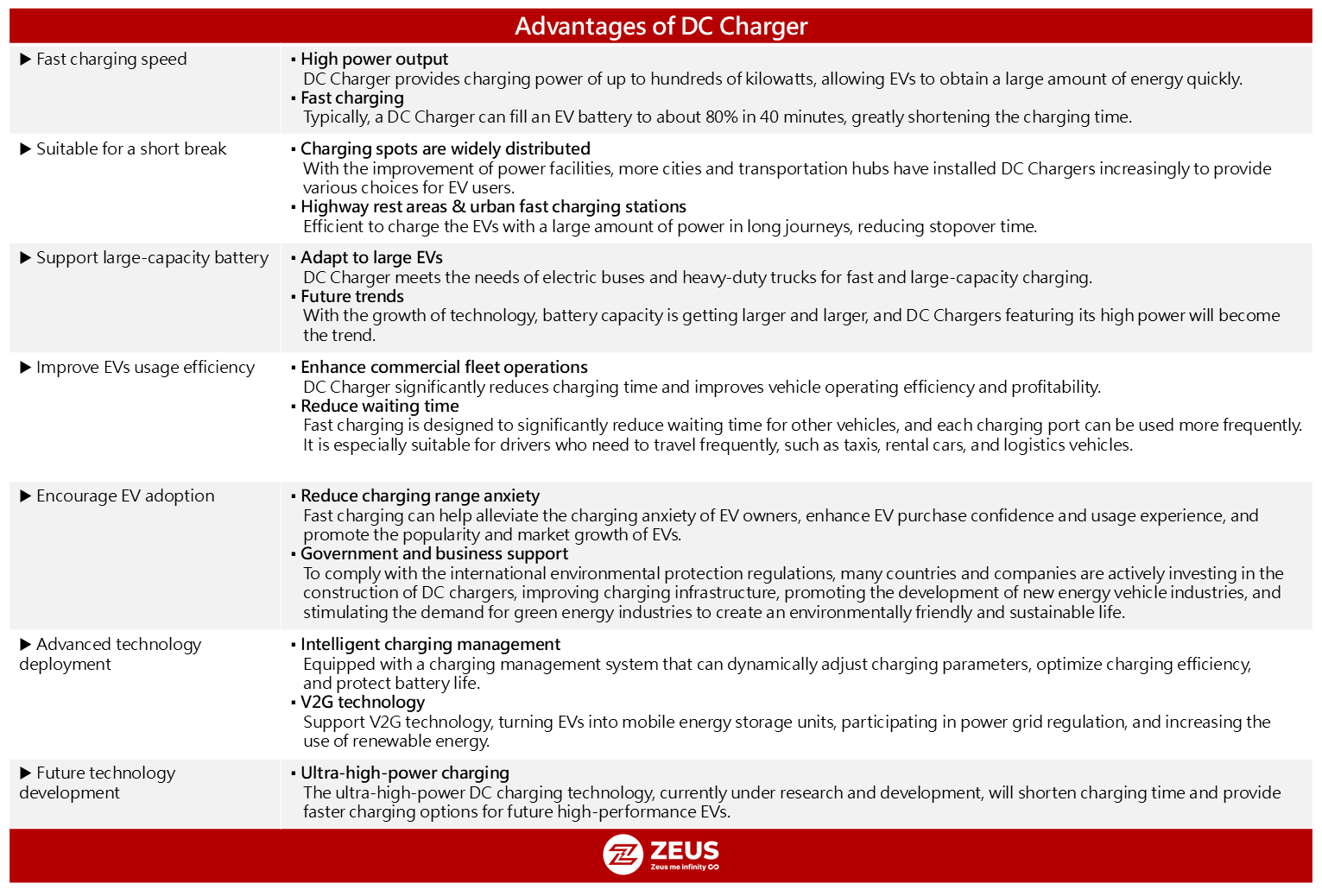Charging 101
𐓏 Charging 101 𐓏
What is an electric vehicle charging pile?
An electric vehicle charging pile (or an EV Charger) is a device used to charge electric vehicles (EVs), also known as an electric vehicle supply equipment (EVSE), allowing EVs to replenish enough energy to run smoothly, allowing EVs to replenish enough energy to run smoothly, like assisting with cars in refueling. The location where charging piles are installed is called a charging station.
As supporting equipment for EVs, EV charger have become increasingly popular as the market demand for EVs expands, and have become one of the necessities of life.
1. Charging operation principle and mode
The charging principle of EV chargers mainly assists in transferring power from the grid to the vehicle's battery system.
According to different uses and forms, it is divided into the following main subjects for introduction:
1.1 Charging operation principle
1.1.1 AC Charging
The grid supplies alternating current (AC), which is charged into the car through charging piles. Then, the AC is converted into direct current (DC) through the on board charger (OBC) installed in the EV, and then input into the battery of the EV.
However, since the OBC is installed in the car and is limited by size and weight, the charging power is not high, which results in a slower charging speed and takes a longer time. It is used in slow-speed and medium-speed charging.

AC chargers require a long charging time, typically taking an average of 3 to 8 hours to fully charge. Therefore, they are usually used in residential areas, commercial buildings, restaurants, department stores, hypermarkets, and even overnight hotels, B&Bs, etc., which are very suitable for setting up AC chargers.
In addition to personal use, commercial use not only enhances customer shopping and accommodation experiences but also attracts EV owners to stop and spend. This not only makes your business stand out but also demonstrates the company's commitment to sustainable development.
【Advantages of AC charger】Lower cost, Easy installation, Battery life protection, High versatility, High energy efficiency.

1.1.2 DC Charging
The grid supplies AC, after AC/DC conversion at the charging station, the DC is input into the EV battery. In this method, appropriate power electronic equipment has been installed in the DC charger.
Since there is no need for conversion through OBC, the DC charger design has no size restrictions. Multiple sets of charging modules can be designed to increase the charging power, so the charging speed is faster. It is used in high-speed charging.

DC chargers greatly shorten the charging time of EVs. It takes an average of 30 minutes to 1 hour to fully charge (depending on the actual power of the EV battery and charger), so it is very suitable for EV owners who want to take a short break. It can be used in convenience stores, gas stations, near interchanges, highway rest stops, factories, commercial buildings, restaurants, shopping malls, and even commercial fleets such as taxis and buses.
Because DC chargers involve higher voltages and currents, the design will be more complicated, and special high-power circuits must be installed, so the construction cost is higher. They are often used for commercial purposes to help you alleviate customers' range anxiety and provide faster and more convenient service.
【Advantages of DC charger】Fast charging speed, Supports large-capacity batteries, Suitable for long-distance travel, Improves the utilization rate of chargers, Applies more advanced technologies.

1.2 Calculation of charging units and charging time
The power unit for calculating electrical capacity is "Watt" (W), and the capacity of "1,000 W" can be abbreviated as "1kW", and so on. Common units include 1MW (1000 kW), GW (1000 MW).
So what does kWh mean? How far can my EV travel after it is fully charged?

1.2.1 What does "kW⋅h" mean?
A widely used representation of the kilowatt-hour is "1 kW⋅h", it is commonly used in billing for delivered energy to consumers by electric utility companies.
It is an energy unit that represents the power consumed by an electrical appliance whose power consumption is 1kW and is used continuously for 1 hour (h).
The calculation formula is as follows:
1 kW⋅h = 1 (kW) x 1 (h)
For example,
A. A water cooler that consumes 1 kW of electricity and operates for 1 hr, the power it uses is calculated to be 1 kWh.
B. A desktop computer with a power consumption of 500 W, used for 2 hours, the power it uses is also calculated to be 1 kWh.
1.2.2 How long does it take to charge my car?
The unit of EV battery capacity is kilowatt-hour (kWh), which refers to the amount of electricity stored in the battery.
The current common EV battery capacity is about 60-80kWh, with the development of technology, different brands also have cars with better performance. For example, the high-end model of Audi Q8 e-tron model has a battery capacity of 114 kWh.
The calculation formula is as follows:
Charging time (hours) = battery capacity (kWh) / charging power (kW)
Let's do a simple exercise:
Assume that there is an EV with a battery capacity of 90kWh and it is charged using a 180kW EV charger.
Without considering other factors, how long will it take to fully charge?
90 (kWh) / 180 (kW) = 0.5 hours
It takes about half an hour.
There are many factors that affect battery capacity, such as temperature, amount of battery active materials, discharge termination voltage, etc. Therefore, the above calculation method is an "approximate" calculation and is only for reference. It should be based on the actual battery and charging conditions.
1.2.3 How far can my EV travel after it is fully charged?
How far an EV can travel is mainly calculated by calculating its energy efficiency, also called energy consumption. This requires an energy consumption test to know the actual number.
The calculation method is "How many kilometers can an EV consume 1kWh of electricity? " in units such as kilometer per kilowatt-hour (km/kWh).
Depending on each EV model and driving habits, the energy consumption of EVs varies. On average, each kilowatt-hour of electricity can travel about 4 to 6 kilometers.
Let's do a simple exercise:
Suppose you have an EV, and you use a 180kW charger to charge your car for 0.5 hours.
180 kW * 0.5 h = 90 kWh
You will use 90 kWh of electricity to charge your car.
Assume that your EV can travel 5 kilometers on average per kilowatt-hour of electricity.
90 kWh * 5 km/kWh = 450 km
Your EV can travel approximately 450 kilometers.
1.2.4 Four test standards for cruising range
When many car owners consider purchasing an EV, they have doubts and worries about the range, which is the so-called "range anxiety." The calculation unit of cruising range is kilometers (Km).
Under different testing environments, conditions and methods, even if it is the same model, there will also be a certain gap in the mileage data tested.
At present, the common international testing standards are mainly the following three:
𖡡 New European Driving Cycle (NEDC)
Standards established by the European Union in the 1970s, tested by turning off all electronic devices on the car and using large fans as wind resistance. The process will simulate urban and non-urban driving conditions respectively, and finally give the average cruising range.
The conditions of the NEDC test simulation are designed without considering external factors, which are very different from actual road driving conditions.
Therefore, most of the NEDC test result data are very good, if converted to actual driving situations, there will be a gap between the actual data and test result data.
𖡡 Worldwide Harmonized Light vehicles Test Procedure (WLTP)
The standard improved by the European Union in 2017, like NEDC, is simulated and tested in a laboratory environment.
WLTP does not consider external factors such as weather and human factors. Still, the standard process is more complex and rigorous, and many variables are added (parameters are adjusted according to vehicle weight, horsepower, etc.).
Therefore, compared to NEDC, WLTP is more in line with the actual driving conditions of EV owners' situation.
𖡡 Environmental Protection Agency (EPA)
Test standards developed for the EPA and specific to the US market.
During the test, the vehicle needs to be fully charged and turned off for 24 hours before testing. It mainly simulates the real conditions in urban areas and highway sections and will frequently accelerate and decelerate.
Since the test will consider environmental factors such as temperature, weight, wind resistance, and human factors, and the score will be directly deducted by 30%, it is regarded as the most stringent test standard. The result data will not look good, but the test results are the closest realistic driving situations.
Overall test data reliability: EPA > WLTP > NEDC
However, since the EPA is mainly an exclusive standard for the US market and is not used in other countries, the more common data in Taiwan are NEDC and WLTP.
In China's domestic EV market, there is another driving condition test standard CLTC specifically for domestic light-duty EVs. A brief introduction is as follows:
𖡡 China Light-duty Vehicle Test Cycle (CLTC)
The test process is a bit like NEDC, which comprehensively simulates the road condition analysis of vehicles on different road conditions such as Chinese urban roads and suburban highways. The test results reflect the actual driving conditions of EVs in China.
1.3 How to choose an EV charger that suits you? Can I install a charging device at home?
Evaluation conditions for purchasing EVs, in addition to evaluating the energy expenses of fuel vehicles and EVs, the convenience of charging is the focus of car owners.
Compared to waiting in line at public charging stations, installing a private charger in your own parking space offers several advantages. You won't waste time queuing and will have the flexibility to charge your car whenever convenient. You can easily fully charge your car and go out.
Depending on relevant preferential policies of local government, you can also enjoy dedicated electricity prices, and saving money.

1.3.1 Understand the environment where the charging device is expected to be installed
There are thousands of environments for installing charging piles, and there will be different situations. Therefore, it is the first prerequisite to understand the environment in which the charging device will be installed. It is also necessary for qualified professionals to assist in evaluation and installation, and to comply with local laws and regulations.
Taipower's explanation in the 725th issue of Taipower monthly magazine:
A single-family private house with an independent garage is the simplest. That is, you can decide to install charging piles without the consent of others. At the same time, you need to confirm that the power in the home is sufficient. The rest is to solve the wiring.
Suppose it is a collective community housing or apartment building with a management committee, and they have an underground parking area. In that case, the consent of the management committee must be obtained when installing charging piles.
Regardless of whether it is a new project or an existing old community building, you can apply for the installation of home charging piles. The application procedures for the two are the same, the only difference is "the name of the applicant". The new community may be under construction, so it is advisable to apply in the name of the building license holder, while for the old community, apply in the name of the management committee.
Source:Taipower Monthly Issue 725 (visit the website)
1.3.2 Understand your charging purposes and needs
A. Evaluated based on daily driving mileage
【Short mileage】
If your average mileage is about 30-50 kilometers, a home AC charger is sufficient.
【Frequent long-distance commuting/business trips/travel】
Depending on the distance, budget, etc., the setting of a DC fast charger can be considered.
It is also recommended that you plan a driving route with sufficient public DC chargers in advance to help you have a smooth journey.
B. Evaluated by charging frequency
【Charging at home overnight】
A home AC charger can meet your needs.
【Frequent need for quick charging】
If your budget is sufficient, you can consider the necessity of setting up a DC fast charger.
1.3.3 Know the specifications of your EV
A. EV built-in OBC capacity
First, confirm the power limit of the EV's OBC to avoid unnecessary overhead.
For example, assuming that the OBC power upper limit of EV is 7.2kW. Purchasing higher-power AC chargers such as 11kW will not increase the charging speed, which is an unnecessary cost.
B. Charging interface specifications
Just like the Micro USB port for mobile phone charging cannot be connected to the Lightning charging cable, different brands or new/old car models, might have different kinds of charging connectors.
The charging port also needs to be confirmed, to ensure that the charging port specifications are the same, or you have a qualified adapter to use.
Currently, common interfaces include Type 1 (SAE J1772), Type 2 (Mennekes), CHAdeMO, NACS, CCS1, CCS2, GB/T, etc., as well as the new specification ChaoJi developed in recent years.
1.3.4 Choose the right EV charger
If you are charging at home at night and can accept a longer charging time, an AC charger will be a good choice for you, and the installation price is lower.
If you are a supermarket/office operator, or you operate a travel rest stop, etc., and have fast charging needs, you can consider DC chargers. Although the installation cost is higher, the charging speed is fast, and it is suitable for short breaks or emergency charging needs.
1.3.5 Budget considerations
A. Equipment costs
In terms of the cost of simply purchasing EV charger equipment, the cost of AC chargers is lower, while the cost of DC chargers is higher.
For example, assuming that the OBC power upper limit of EV is 7.2kW. Purchasing higher-power AC chargers such as 11kW will not increase the charging speed, which is an unnecessary cost.
B. Installation costs
The cost of setting up charging equipment, such as power system configuration, installation of charging equipment, hiring of professionals, etc.
C. Operating costs
The expenses that may be incurred during the use of chargers include electricity bills, maintenance fees, etc.
1.3.6 Evaluation of performance, protection coefficient, etc.
A. Intelligent charging management
You can monitor and control the charging process, set charging time, view charging records, etc. through the mobile App.
B. Security protection configuration
Choose a charger with comprehensive safety functions such as overload protection, short-circuit protection, waterproofing, and dustproof to ensure safe use.
1.3.7 Brand, safety certification, etc.
A. Brand goodwill
You can choose based on personal preference or a brand with a good reputation.
B. Safety certification
According to international or local national regulations, you can choose EV chargers with complete certification to ensure that products comply with regulations, such as CE, UL, etc.
C. After-sales service
Different brands have different after-sales services. You can choose a complete after-sales service plan that meets your needs so that you can use EV chargers with peace of mind.
Need more help?
Please submit a business support request and our experts will get in touch with you.

Business & Products



Business & Products



Business & Products


